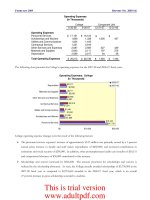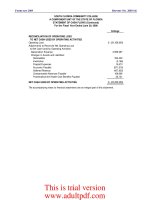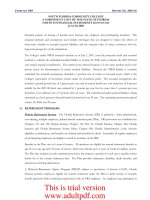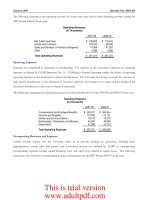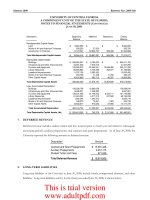REPORT NO. 2009-176 MARCH 2009 FLORIDA COMMUNITY COLLEGE AT JACKSONVILLE_part4 pptx
Bạn đang xem bản rút gọn của tài liệu. Xem và tải ngay bản đầy đủ của tài liệu tại đây (245.73 KB, 11 trang )
MARCH 2009 REPORT NO. 2009-176
FLORIDA COMMUNITY COLLEGE AT JACKSONVILLE
A COMPONENT UNIT OF THE STATE OF FLORIDA
NOTES TO FINANCIAL STATEMENTS (C
ONTINUED)
J
UNE 30, 2008
-30-
Description Amount
Normal Cost (Service Cost for One Year) 507,178$
Amortization of Unfunded Actuarial
Accrued Liability 360,898
Interest on Normal Cost and Amortization 34,723
Annual Required Contribution
902,799
Interest on Net OPEB Obligation -
Adjustment to Annual Required Contribution -
Annual OPEB Cost (Expense)
902,799
Contribution Toward the OPEB Cost (464,511)
Increase in Net OPEB Obligation
438,288
Net OPEB Obligation, Beginning of Year -
Net OPEB Obligation, End of Year
438,288$
The College’s annual OPEB cost, the percentage of annual OPEB cost contributed to the plan, and the net
OPEB obligation as of June 30, 2008 (the year of implementation), was as follows:
Fiscal Yea
r
A
nnual Percenta
g
e of Net OPEB
OPEB Cos
t
A
nnual Obli
g
ation
OPEB Cos
t
Contributed
Be
g
innin
g
Balance, Jul
y
1, 2007 $ $
2007-0
8
902,79
9
51.5% 438,288
Funded Status and Funding Progress. As of July 1, 2008, the actuarial accrued liability for benefits was
$10,585,442, and the actuarial value of assets was $0, resulting in an unfunded actuarial accrued liability of
$10,585,442. The covered payroll (annual payroll of active participating employees) was $57,986,868 for
the 2007-08 fiscal year, and the ratio of the unfunded actuarial accrued liability to the covered payroll was
18.3 percent.
Actuarial Methods and Assumptions. Actuarial valuations of an ongoing plan involve estimates of the value of
reported amounts and assumptions about the probability of occurrence of events far into the future.
Examples include assumptions about future employment and termination, mortality, and health care cost
trends. Amounts determined regarding the funded status of the plan and the annual required contributions
of the employer are subject to continual revision as actual results are compared with past expectations and
new estimates are made about the future. Projections of benefits for financial reporting purposes are based
This is trial version
www.adultpdf.com
MARCH 2009 REPORT NO. 2009-176
FLORIDA COMMUNITY COLLEGE AT JACKSONVILLE
A COMPONENT UNIT OF THE STATE OF FLORIDA
NOTES TO FINANCIAL STATEMENTS (C
ONTINUED)
J
UNE 30, 2008
-31-
on the substantive plan provisions, as understood by the employer and participating members, and include
the types of benefits provided at the time of each valuation and the historical pattern of sharing of benefit
costs between the employer and participating members. The actuarial methods and assumptions used
include techniques that are designed to reduce the effects of short-term volatility in actuarial accrued
liabilities and the actuarial value of assets, consistent with the long-term perspective of the calculations.
The College’s initial OPEB actuarial valuation as of July 1, 2007, used the entry age cost actuarial method
to estimate the unfunded actuarial liability as of June 30, 2008, and to estimate the 2007-08 fiscal year
annual required contribution. This method was selected because it was the most common such method
used for government pension valuation and spreads the costs evenly throughout the collective careers of
those in the covered workforce. Because the OPEB liability is currently unfunded, the actuarial
assumptions included a 4 percent rate of return on invested assets, which is the College’s expectation of
investment returns under its investment policy. The actuarial assumptions also included a payroll growth
rate of 3.5 percent per year, and an annual health care cost trend rate of 11.5 percent initially for the
2007-08 fiscal year, decreasing by 1 percent per year, to an ultimate rate of 5.5 percent after six years. The
unfunded actuarial accrued liability is being amortized over 30 years as a level percentage of projected
payroll on a closed basis. The remaining amortization period at June 30, 2008, was 29 years.
10. RETIREMENT PROGRAMS
Florida Retirement System
. The Florida Retirement System (FRS) is primarily a State-administered,
cost-sharing, multiple-employer, defined-benefit retirement plan (Plan). FRS provisions are established by
Chapters 121 and 122, Florida Statutes; Chapter 112, Part IV, Florida Statutes; Chapter 238, Florida
Statutes; and Florida Retirement System Rules, Chapter 60S, Florida Administrative Code; wherein
eligibility, contributions, and benefits are defined and described in detail. Essentially all regular employees
of participating employers are eligible to enroll as members of the FRS.
Benefits in the Plan vest at 6 years of service. All members are eligible for normal retirement benefits at
age 62 or at any age after 30 years of service, which may include up to 4 years of credit for military service.
The Plan also includes an early retirement provision, but imposes a penalty for each year a member retires
before his or her normal retirement date. The Plan provides retirement, disability, death benefits, and
annual cost-of-living adjustments.
A Deferred Retirement Option Program (DROP) subject to provisions of Section 121.091, Florida
Statutes, permits employees eligible for normal retirement under the Plan to defer receipt of monthly
benefit payments while continuing employment with an FRS employer. An employee may participate in
This is trial version
www.adultpdf.com
MARCH 2009 REPORT NO. 2009-176
FLORIDA COMMUNITY COLLEGE AT JACKSONVILLE
A COMPONENT UNIT OF THE STATE OF FLORIDA
NOTES TO FINANCIAL STATEMENTS (C
ONTINUED)
J
UNE 30, 2008
-32-
the DROP for a period not to exceed 60 months after electing to participate. During the period of DROP
participation, deferred monthly benefits are held in the FRS Trust Fund and accrue interest.
The State of Florida establishes contribution rates for participating employers. Contribution rates during
the 2007-08 fiscal year were as follows:
Class or Plan
Percent of Gross Salary
Employee Employer
(A)
Florida Retirement System, Regular
0.00 9.85
Florida Retirement System, Senior Management Service
0.00 13.12
State and County Officers and Employees' Retirement
System, Plan B
4.00 9.10
Deferred Retirement Option Program - Applicable to
Members from All of the Above Classes or Plan
0.00 10.91
Florida Retirement System, Reemployed Retiree
(B) (B)
Notes:
(A)
(B)
Employer rates include 1.11 percent for the postemployment health
insurance subsidy. Also, employer rates, other than for DROP participants,
include .05 percent for administrative costs of the Public Employee Optional
Retirement Program.
Contribution rates are dependent upon retirement class or plan in which
reemployed.
The College’s liability for participation is limited to the payment of the required contribution at the rates
and frequencies established by law on future payrolls of the College. The College’s contributions, including
employee contributions, for the fiscal years ended June 30, 2006, June 30, 2007, and June 30, 2008, totaled
$3,694,546, $4,724,796, and $4,719,509, respectively, which were equal to the required contributions for
each fiscal year.
Section 121.4501, Florida Statutes, provides for a Public Employee Optional Retirement Program
(PEORP). The PEORP is a defined-contribution plan alternative available to all FRS members in lieu of
the FRS defined-benefit plan. College employees already participating in the State Community College
System Optional Retirement Program or the DROP are not eligible to participate in this program.
Employer contributions are defined by law, but the ultimate benefit depends in part on the performance of
investment funds. The PEORP is funded by employer contributions that are based on salary and
membership class (Regular Class, Special Risk Class, etc.). Contributions are directed to individual member
accounts, and the individual members allocate contributions and account balances among various approved
investment choices. Benefits in the plan vest at one year of service. There were 219 College participants
during the 2007-08 fiscal year. Required contributions made to the PEORP totaled $704,452.
This is trial version
www.adultpdf.com
MARCH 2009 REPORT NO. 2009-176
FLORIDA COMMUNITY COLLEGE AT JACKSONVILLE
A COMPONENT UNIT OF THE STATE OF FLORIDA
NOTES TO FINANCIAL STATEMENTS (C
ONTINUED)
J
UNE 30, 2008
-33-
Financial statements and other supplementary information of the FRS are included in the State’s
Comprehensive Annual Financial Report, which is available from the Florida Department of Financial
Services. An annual report on the FRS, which includes its financial statements, required supplementary
information, actuarial report, and other relevant information, is available from the Florida Department of
Management Services, Division of Retirement.
State Community College System Optional Retirement Program. Section 1012.875, Florida Statutes,
provides for an Optional Retirement Program (Program) for eligible community college instructors and
administrators. The Program is designed to aid community colleges in recruiting employees by offering
more portability to employees not expected to remain in the FRS for six or more years.
The Program is a defined-contribution plan, which provides full and immediate vesting of all contributions
submitted to the participating companies on behalf of the participant. Employees in eligible positions can
make an irrevocable election to participate in the Program, rather than the FRS, and purchase retirement
and death benefits through contracts provided by certain insurance carriers. The employing community
college contributes, on behalf of the participant, 10.43 percent of the participant’s salary, less a small
amount used to cover administrative costs. The remaining contribution is invested in the company or
companies selected by the participant to create a fund for the purchase of annuities at retirement. The
participant may contribute, by payroll deduction, an amount not to exceed the percentage contributed by
the community college to the participant’s annuity account.
There were 176 College participants during the 2007-08 fiscal year. Required employer contributions made
to the Program totaled $1,069,662.
11. SENIOR MANAGEMENT SERVICE CLASS LOCAL ANNUITY PROGRAM
Section 121.055, Florida Statutes, and Florida Retirement System Rule 60S-1.0057, Florida Administrative
Code, provide that local agency employees eligible for Florida Retirement System, Senior Management
Service Class may elect to withdraw from the Florida Retirement System (FRS) altogether and participate in
a lifetime monthly annuity program offered by the local agency. Pursuant thereto, the College established a
Senior Management Service Class Local Annuity Program (Program). Employees in eligible positions are
allowed to make an irrevocable election to participate in the program, rather than the FRS. Under the
program, the College contributes the same percentage of the participant’s salary as would have been
contributed to the FRS, for the Senior Management Service Optional Annuity Program toward an annuity
provided by approved fund sponsors. The participant does not make any contributions to the Program.
This is trial version
www.adultpdf.com
MARCH 2009 REPORT NO. 2009-176
FLORIDA COMMUNITY COLLEGE AT JACKSONVILLE
A COMPONENT UNIT OF THE STATE OF FLORIDA
NOTES TO FINANCIAL STATEMENTS (C
ONTINUED)
J
UNE 30, 2008
-34-
As of June 30, 2008, six College employees had opted to participate in the Program. Contributions made
by the College to the program totaled $127,938 during the 2007-08 fiscal year.
12. CONSTRUCTION COMMITMENTS
The College’s major construction commitments at June 30, 2008, are as follows:
Project Description Total Completed Balance
Commitment to Date Committed
Deerwood Center - New Mall Space:
General Contractor 10,379,880$ 5,797,417$ 4,582,463$
Architect 985,789 870,976 114,813
Downtown Campus - Buildings A and URC:
General Contractor 9,185,102 7,971,727 1,213,375
Architect 1,260,593 1,167,152 93,441
South Campus - Various Buildings:
General Contractor 4,813,894 3,548,006 1,265,888
Architect 724,362 669,747 54,615
Cecil Center - Aerospace Resource Center:
General Contractor 2,145,961 752,964 1,392,997
Architect 302,008 215,129 86,879
Cecil Center - Aircraft Coating Educational Facility:
Architect 671,782 159,583 512,199
Total 30,469,371$ 21,152,701$ 9,316,670$
13. RISK MANAGEMENT PROGRAMS
The College is exposed to various risks of loss related to torts; theft of, damage to, and destruction of
assets; errors and omissions; injuries to employees; and natural disasters. The College provided coverage
for these risks through a self-insured program and commercially purchased insurance.
Self-Insured Program
. The Board has established an individual self-insured program to provide group
health insurance for its employees, retirees, former employees, and their dependents. The College’s liability
was limited by excess reinsurance to $150 thousand per insured person with an aggregate medical claim cap
of $12.3 million for the 2007-08 fiscal year. The plan is provided by an insurance company licensed by the
Florida Department of Financial Services, Office of Insurance Regulation. The College contributes
employee premiums as a fringe benefit. Employee dependent coverage is by payroll deduction and
coverage for retirees, former employees, and their dependents is by prepaid premium.
The College reports liabilities when it is probable that a loss has occurred and the amount of that loss can
be reasonably estimated. Liabilities include an amount for claims that have been incurred, but not
reported. Because actual claims liabilities depend upon such complex factors as inflation, change in legal
This is trial version
www.adultpdf.com
MARCH 2009 REPORT NO. 2009-176
FLORIDA COMMUNITY COLLEGE AT JACKSONVILLE
A COMPONENT UNIT OF THE STATE OF FLORIDA
NOTES TO FINANCIAL STATEMENTS (C
ONTINUED)
J
UNE 30, 2008
-35-
doctrines, and damage awards, the process used in computing the claims liabilities does not necessarily
result in an exact amount. The College reevaluates claims liabilities periodically and the claims liabilities
totaled $2,335,696 as of June 30, 2008.
The following schedule represents the changes in the claims liability for the past two fiscal years for the
College’s self-insured group health insurance program:
Fiscal Beginning Claims and Claim End of
Year of Fiscal Changes in Payments Fiscal
Year Estimates Year
2006-07 2,098,379$ 9,767,721$ (9,680,223)$ 2,185,877$
2007-08 2,185,877 9,508,532 (9,358,713) 2,335,696
The College has an individual self-insured program to provide workers’ compensation coverage for its
employees. The College’s liability was limited by excess reinsurance to $350 thousand per occurrence for
the 2007-08 fiscal year. The program administrator has been approved by the Florida Department of
Financial Services, Office of Insurance Regulation. An actuarial review has determined a present value of
estimated outstanding losses, including incurred but not reported claims, in the amount of $210,268
discounted at a rate of 5 percent, at June 30, 2008.
The following schedule represents the changes in the claims liability for the past two fiscal years for the
College’s self-insured workers’ compensation program:
Fiscal Beginning Claims and Claim End of
Year of Fiscal Changes in Payments Fiscal
Year Estimates Year
2006-07 360,398$ 170,851$ (223,507)$ 307,742$
2007-08 307,742 50,431 (147,905) 210,268
Amounts held by the College for the self-insured group health and workers’ compensation programs in
excess of estimated insurance claims payable at June 30, 2008, totaling $3,161,851, are classified as
insurance contributions payable on the statement of net assets. The College will use these moneys to pay
future claims.
Settled claims arising from risks associated with the self-insured programs have not exceeded coverage in
any of the past three fiscal years.
This is trial version
www.adultpdf.com
MARCH 2009 REPORT NO. 2009-176
FLORIDA COMMUNITY COLLEGE AT JACKSONVILLE
A COMPONENT UNIT OF THE STATE OF FLORIDA
NOTES TO FINANCIAL STATEMENTS (C
ONTINUED)
J
UNE 30, 2008
-36-
Commercially Purchased Insurance. The College’s insurance coverages for property, boiler and
machinery, general liability, automobile liability, employee faithful performance, employee benefits liability,
errors and omissions, and student professional liability were obtained through commercially purchased
insurance. The College has also designated net assets of $2,822,000 in recognition of its five percent wind
and hail property damage deductible in the event of major storm damage.
Settled claims arising from these risk have not exceeded coverage in any of the past three fiscal years.
14. LITIGATION
The College is involved in several pending and threatened legal actions. The range of potential loss from
all such claims and actions, as estimated by the College’s legal counsel and management, should not
materially affect the College’s financial position.
15. SCHEDULE OF STATE REVENUE SOURCES
Revenue from State sources for current operations is primarily from the Community College Program
Fund administered by the Florida Department of Education under the provisions of Section 1011.81,
Florida Statutes. In accordance with Section 1011.84, Florida Statutes, the Legislature determines each
college’s apportionment considering the following components: base budget, which includes the State
appropriation to the Community College Program Fund in the current year plus the related student tuition
and fees assigned in the current General Appropriations Act; the cost-to-continue allocation, which
consists of incremental changes to the base budget, including salaries, price levels, and other related costs;
enrollment workload adjustments; operation costs of new facilities adjustments; and new and improved
program enhancements, which are determined by the Legislature. Student fees in the base budget plus
student fee revenues generated by increases in fee rates are deducted from the sum of these components to
determine the net annual State apportionment to each college.
The State allocates gross receipts taxes, generally known as Public Education Capital Outlay money, to the
College on an annual basis. The College is authorized to receive and expend these resources only upon
applying for and receiving an encumbrance authorization from the Florida Department of Education.
This is trial version
www.adultpdf.com
MARCH 2009 REPORT NO. 2009-176
FLORIDA COMMUNITY COLLEGE AT JACKSONVILLE
A COMPONENT UNIT OF THE STATE OF FLORIDA
NOTES TO FINANCIAL STATEMENTS (C
ONTINUED)
J
UNE 30, 2008
-37-
The following is a summary of State revenue sources and amounts:
Source Amount
Community College Program Fund 72,564,508$
Gross Receipts Tax (Public Education Capital Outlay) 32,084,509
8,311,169
Florida Student Assistance Grants 4,779,129
Restricted Contracts and Grants 3,408,970
Bright Futures Scholarship Program 2,538,412
Performance Based Incentives 1,606,968
Motor Vehicle License Tax (Capital Outlay and Debt Service) 1,086,039
Other State Sources 32,562
Total
126,412,266$
Education Enhancement Trust Fund (Lottery)
16. FUNCTIONAL DISTRIBUTION OF OPERATING EXPENSES
The functional classification of an operating expense (instruction, academic support, etc.) is assigned to a
department based on the nature of the activity, which represents the material portion of the activity
attributable to the department. For example, activities of an academic department for which the primary
departmental function is instruction may include some activities other than direct instruction such as public
service. However, when the primary mission of the department consists of instructional program
elements, all expenses of the department are reported under the instruction classification. The operating
expenses on the statement of revenues, expenses, and changes in net assets are presented by natural
classifications. The following are those same expenses presented in functional classifications as
recommended by NACUBO:
Functional Classification Amount
Instruction 69,261,016$
Public Services 1,590,423
Academic Support 23,138,347
Student Services 14,569,483
Institutional Support 20,921,623
Operation and Maintenance of Plant 27,016,028
Scholarships and Fellowships 14,813,118
Depreciation 7,991,230
Total Operating Expenses 179,301,268$
This is trial version
www.adultpdf.com
MARCH 2009 REPORT NO. 2009-176
FLORIDA COMMUNITY COLLEGE AT JACKSONVILLE
A COMPONENT UNIT OF THE STATE OF FLORIDA
NOTES TO FINANCIAL STATEMENTS (C
ONTINUED)
J
UNE 30, 2008
-38-
17. RELATED PARTY TRANSACTIONS
The College entered into an agreement with the Florida Community College Foundation, Inc., to serve as
the contracting agent and execute performance agreements for the FCCJ Artist Series, a co-sponsored
program of the College and the Foundation that provides a wide variety of cultural events (theatre
productions, concerts, etc.). The agreement was effective for the 2007-08 fiscal year and provided, in part,
for the Foundation to reimburse the College $700,000 from the Artist Series surplus as reimbursement for
salaries, benefits, and administrative costs paid by the College, except that the College reserved the right to
waive the reimbursement in part or whole in the best interest of the College. On June 3, 2008, the Board
of Trustees approved waiving reimbursement for $709,411 in Artist Series expenses incurred by the
College, and the College elected to not bill the Foundation for $449,170 in other Foundation support
expenses. As a result of these transactions, the College provided in-kind contributions to the Foundation,
totaling $1,158,581, to support Foundation scholarship activities.
The amount due from component unit at year-end consists of amounts owed to the College by the
Foundation for Artist Series performance expenses in excess of related performance revenues. At
June 30, 2008, the net expense due from the Foundation totaled $199,655.
This is trial version
www.adultpdf.com
MARCH 2009 REPORT NO. 2009-176
-39-
AUDITOR GENERAL
STATE OF FLORIDA
G74 Claude Pepper Building
111 West Madison Street
Tallahassee, Florida 32399-1450
The President of the Senate, the Speaker of the
House of Representatives, and the
Legislative Auditing Committee
INDEPENDENT AUDITOR’S REPORT ON INTERNAL CONTROL OVER
FINANCIAL REPORTING AND ON COMPLIANCE AND OTHER MATTERS
BASED ON AN AUDIT OF THE FINANCIAL STATEMENTS PERFORMED
IN ACCORDANCE WITH
GOVERNMENT AUDITING STANDARDS
We have audited the financial statements of Florida Community College at Jacksonville, a component unit of the
State of Florida, and its discretely presented component unit as of and for the fiscal year ended June 30, 2008, which
collectively comprise the College’s basic financial statements, and have issued our report thereon included under the
heading INDEPENDENT AUDITOR’S REPORT ON FINANCIAL STATEMENTS. Our report on the
financial statements was modified to include a reference to other auditors. We conducted our audit in accordance
with auditing standards generally accepted in the United States of America and the standards applicable to financial
audits contained in Government Auditing Standards issued by the Comptroller General of the United States. Other
auditors audited the financial statements of the discretely presented component unit as described in our report on
the College’s financial statements. This report does not include the results of the other auditors’ testing of internal
control over financial reporting or compliance and other matters that are reported on separately by those auditors.
Internal Control Over Financial Reporting
In planning and performing our audit, we considered the College’s internal control over financial reporting as a basis
for designing our auditing procedures for the purpose of expressing our opinions on the financial statements, but
not for the purpose of expressing an opinion on the effectiveness of the College’s internal control over financial
reporting. Accordingly, we do not express an opinion on the effectiveness of the College’s internal control over
financial reporting.
A control deficiency exists when the design or operation of a control does not allow management or employees, in the
normal course of performing their assigned functions, to prevent or detect misstatements on a timely basis. A
significant deficiency is a control deficiency, or combination of control deficiencies, that adversely affects the College’s
ability to initiate, authorize, record, process, or report financial data reliably in accordance with generally accepted
DAVID W. MARTIN, CP
A
AUDITOR GENERAL
PHONE: 850-488-5534
F
AX: 850-488-6975
This is trial version
www.adultpdf.com
MARCH 2009 REPORT NO. 2009-176
-40-
accounting principles such that there is more than a remote likelihood that a misstatement of the College’s financial
statements that is more than inconsequential will not be prevented or detected by the College’s internal control.
A material weakness is a significant deficiency, or combination of significant deficiencies, that results in more than a
remote likelihood that a material misstatement of the financial statements will not be prevented or detected by the
College’s internal control.
Our consideration of internal control over financial reporting was for the limited purpose described in the first
paragraph of this section and would not necessarily identify all deficiencies in internal control that might be
significant deficiencies or material weaknesses. We did not identify any deficiencies in internal control over financial
reporting that we consider to be material weaknesses, as defined above.
Compliance and Other Matters
As part of obtaining reasonable assurance about whether the College’s financial statements are free of material
misstatement, we performed tests of its compliance with certain provisions of laws, rules, regulations, contracts, and
grant agreements, noncompliance with which could have a direct and material effect on the determination of
financial statement amounts. However, providing an opinion on compliance with those provisions was not an
objective of our audit and, accordingly, we do not express such an opinion. The results of our tests disclosed no
instances of noncompliance or other matters that are required to be reported under Government Auditing Standards.
Pursuant to Section 11.45(4), Florida Statutes, this report is a public record and its distribution is not limited.
Auditing standards generally accepted in the United States of America require us to indicate that this report is
intended solely for the information and use of the Legislative Auditing Committee, members of the Florida Senate
and the Florida House of Representatives, Federal and other granting agencies, and applicable management and is
not intended to be and should not be used by anyone other than these specified parties.
Respectfully submitted,
David W. Martin, CPA
March 10, 2009
This is trial version
www.adultpdf.com

